![]()
![]()
![]()
Use LEFT and RIGHT arrow keys to navigate between flashcards;
Use UP and DOWN arrow keys to flip the card;
H to show hint;
A reads text to speech;
33 Cards in this Set
- Front
- Back
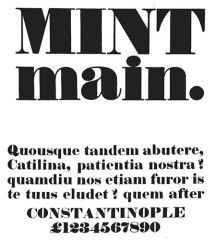
|
Robert Thorne, fat-face types, 1821
Thorne designs first fat face type in 1803 Roman type with increased weight contrasts Becomes a major category of type design 1:2 ratio, stroke width: capital height |
|
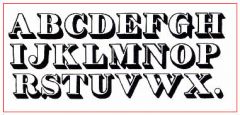
|
Vincent Figgins, five lines pica in shade, 1815
First 3D or perspective fonts Fat fact type in outline with shade |
|

|
William Caslon IV, two-line English Egyptian, 1816
Introduced sans-serif type Without serifs: small line attached to the end of a stroke in a letter or symbol Major category in type design |
|
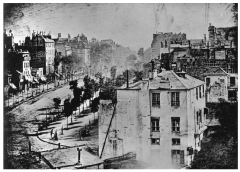
|
Louis Jacques Daguerre, Paris boulevard, 1839
Early daguerreotype: photographic process with greater detail but one-of-a-kind image -- not reproducible Man in lower left street corner and the shoe polisher were first people ever photographed |
|
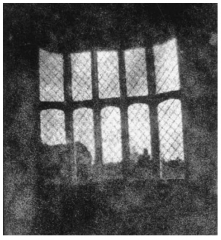
|
William Henry Fox Talbot, print from the first photographic negative, 1835 Image made on light-sensitive paper in a camera obscura Calotype: Talbot's photographic process patented in 1841 Glass windows in large room of his mansion, Lacock Abbey Calotype makes photographic images reproducable |
|
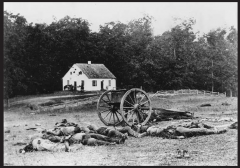
|
Mathew Brady, Dunker Church and the Dead, 1862
Photography as historical documentation Aftermath of the Battle of Antietam, Civil War Possibly "staged" or otherwise altered |
|
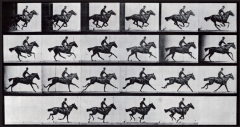
|
Eadweard Muybridge, plate of The Horse in Motion, 1883
Sequence of stop-action photography Paves way for moving images |
|
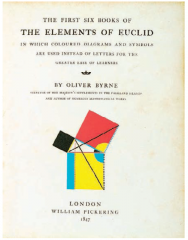
|
William Pickering, title page from The Elements of Euclid, 1847
Pickering: 19th century English publisher Separated graphic design and production This is a landmark in a book design: color wood block prints |
|
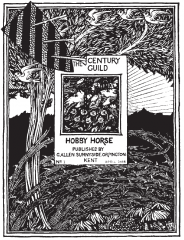
|
Selwyn Image, title page to the Century Guild Hobby Horse, 1884
Hobby Horse: First periodical dedicated exclusively to the visual arts Set forth the ideals of the Century Guild Intricate patterning of earlier styles
|
|
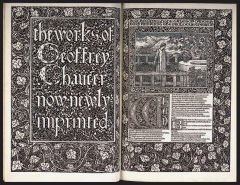
|
William Morris, title page from The Works of Geoffrey Chaucer, 1896
Handmade elements translated to typography Initials, borders, ornaments, illustration: modular, interchangeable, repeatable |
|
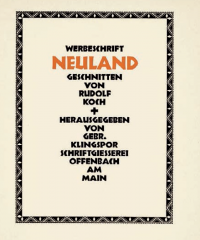
|
Rudolph Koch, specimen of Neuland, 1922-23
Koch: most important German typeface designer in arts and crafts movement Woodcut-inspired ornaments Unprecedented capital C + S |
|
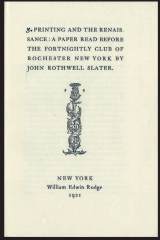
|
Bruce Rogers, title page from Printing and the Renaissance, 1921, by John Rothwell Slater
Rogers: most important American book designer of the era
|
|

|
Jules Cheret, Ice Palace, Champs-Elysee, 1893 Jules Cheret: Son of a typesetter, father of the modern poster, awarded French Legion of Honor, convinced lithography would replace typographic poster Signature style: Figure with animated gesture, swirling colors in background, large bold lettering, typeset matches lines of figure |
|
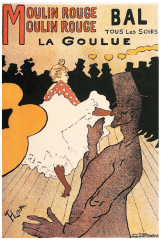
|
Henri de Toulouse-Lautrec, La Goulue au Moulin Rouge, 1891
Crippled after childhood accident that broke both hips He produced 31 posters Drew directly on lithographic stone Simplified shapes and dynamic space |
|

|
A L Rich, trademark for General Electric, 1890
Successful and famous trademark: unique, legible, and unequivocal |
|
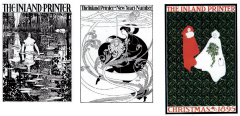
|
Will Bradley, covers for the Inland Printer, 1894 and 1895
Primary practitioner of Art Nouveau in America Inspired by English examples of Art Nouveau Range from complex full tone drawing to imagery reduced to black and white silhouette masses |
|

|
Edward Penfield, poster for Harper's, 1894
Penfield: art director of Harper's 1891-1901 Studied at the Art Student's League: founded 1875 NYC Fluid line, flat color, no background |
|

|
Hans Christiansen, Jugend cover, 1899
Art Nouveau in Germany called jugendstil (youth style) For a magazine named Jugend, whose publication grew to 200k copies per week He was leading artist at Jugend Overlapping typeset |
|

|
Margaret and Frances Macdonald with J Herbert McNair, poster for the Glasgow Institute of the Fine Arts, 1895
Glasgow school: Scotland, 1870's, flourished 1890's-1910 Collaboration of the 4: Frances Macdonald, Margaret Macdonald, Charles Rennie Mackintosh, Herbert MacNair |
|

|
Charles Rennie Mackintosh, poster for the Scottish Musical Review, 1896
Over 8 feet Signature style: flowing lines in rectangular structure, flat areas of color, overlapping panes, symmetrical, clear focal point Mackintosh: "The purpose of a poster is to attract notice." |
|
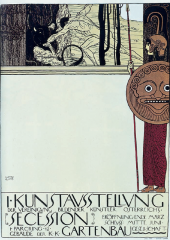
|
Gustav Klimt, poster for the first Vienna Secession exhibition, 1898
Vienna Secession: protest in the Creative Artists Association, April 3, 1897, led by Klimt, not allowing foreign artists, establish their own exhibitions Large open space in the center is unprecedented in Western graphic design |
|
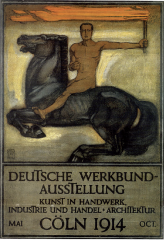
|
Peter Behrens, poster for a Deutsche Werkbund exhibition, 1914 Behrens: German, embraced Jugendstil (youth style), typography mirrored culture, tried to express spirit of new era, 1st industrial designer, designed manufactured products Deutsche Werkbund: German association of craftsmen, advocated union of art and technology Designer as an allegorical torchbearer Subtitle: Art in craft, industry, and commerce-- architecture |
|
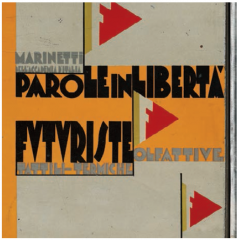
|
Filippo Marinetti, cover for Futurist Words-in-Freedom, 1932
Futurist: launched by marinetto in his manifesto of Futurist poetry, saw war as a way to move out of static place, imagery often full of motion, different sizes, weights, and styles of type allowed them to weld painting and poetry, almost exclusively Italian Words-in-Freedom: new painterly typographic style, noise and speed expressed in poetry |
|
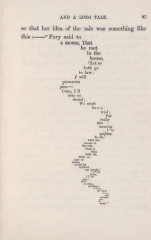
|
Lewis Carroll, typographic image from Alice in Wonderland, 1866
Graphic experiment in figurative typography earned design and literacy acclaim
Descending type sizes into pictorial shape |
|
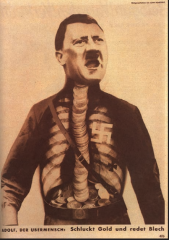
|
John Heartfield, AIZ 11, number 29, page 675, 1932
Heartfield: Berlin Dadaist (anti-art, shock and protest), changed German name to an English sounding name (Helmut Herzfelde) Photomontage: photographic images into collage Headline: "Adolf, the superman: swallows gold and spouts rubbish." Photomontage xray of Hitler showing an esophagus of gold coins |
|
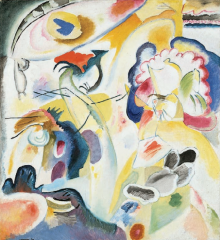
|
Wassily Kandinsky, Improvisation No. 29, 1912
Kandinsky: Leader of German expressionist group known as The Blue Rider, express spiritual truths through art, father of abstract painting, wrote "Concerning the Spiritual in Art" |
|
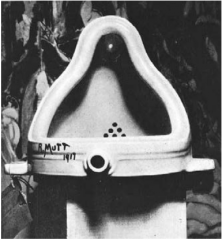
|
Marcel Duchamp, The Fountain, 1917, photographed by Alfred Stieglitz
Dada: anti-art/ nonsense, shock and protest
Ready-made: Mass produced object, object out of context |
|
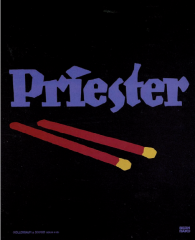
|
Lucien Bernhard, poster for Priester matches, 1905
Plakastil: poster style; German design school, reductive image, powerful color
Product name and image on solid background |
|

|
Alfred Leete, poster for military recruiting, 1915
Allies: Great Britain, France, Russia, USA Lord Horatio Kitchener, British Secretary of War Confronts the spectator with direct gaze |
|
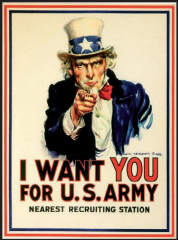
|
James Montgomery Flagg, poster for military recruiting, 1917
American version of Kitchener's Self portrait of Flagg 5 million copies printed One of most widely reproduced posters in history |
|
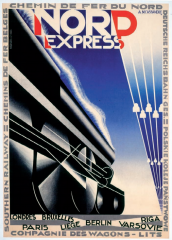
|
A. M. Cassandre, Express Nord poster, 1927
Spirit of art deco: decorative, geometric, style of the 20's and 30's Essence of travel: distant destinations, new experiences, speed and excitement |
|
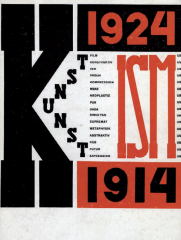
|
El Lissitzky, book cover for The Isms of Art, 1924
One of the most influential book designs of the early 20th century
Creates visual program for organizing information |
|
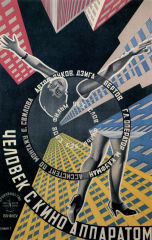
|
Georgy and Vladimir Augustovich Stenberg, film poster for The Man with the Movie Camera, 1929
Stenbergs: Brothers famous for their film posters Spatial distortion: Circular type, fragmented figure |

